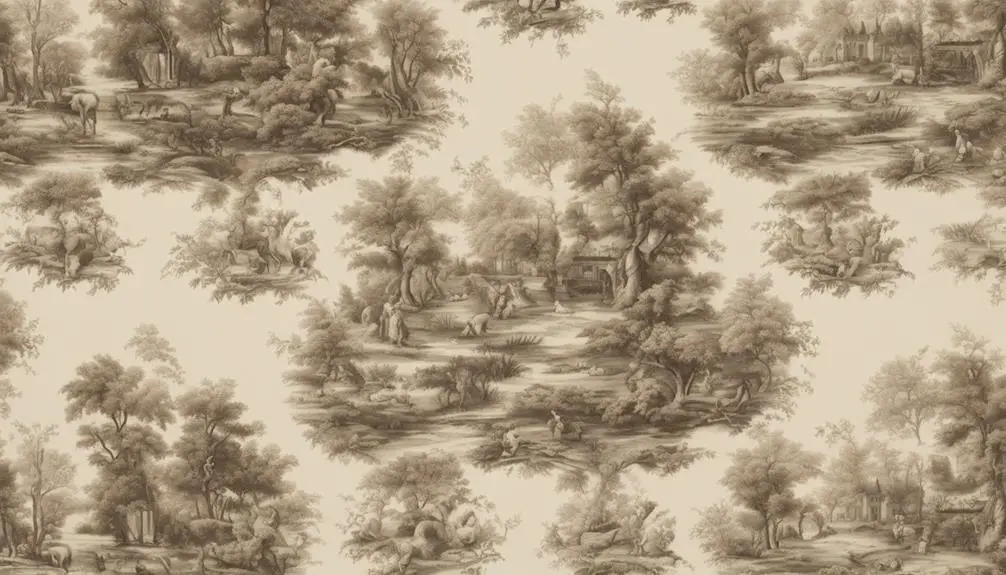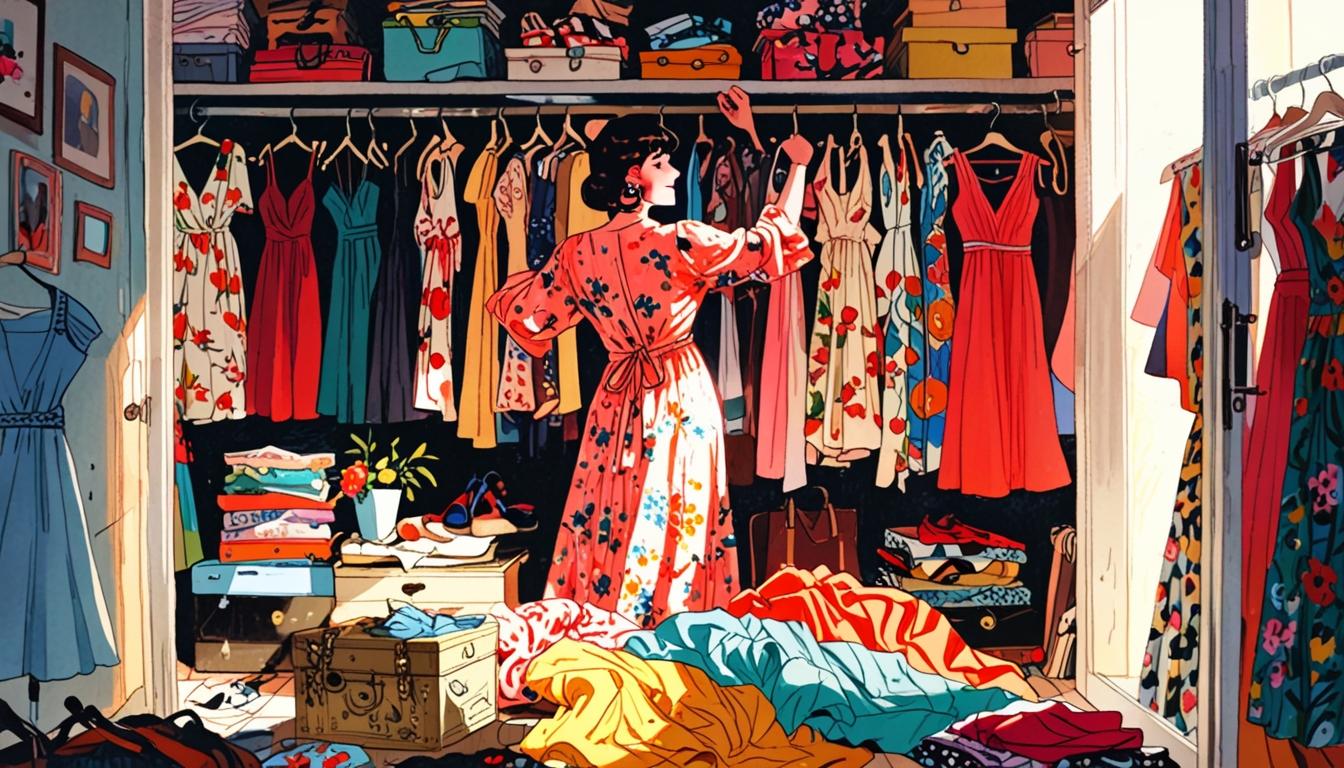To identify toile, look for distinct patterns set against an off-white background. Authentic pieces feature intricate, single-color prints that often tell a story through scenic or floral motifs. Check the fabric quality; genuine toile is usually made from high-quality cotton or linen. If you spot signs of traditional printing techniques, like block or copperplate, that's a good indicator of authenticity. Pay attention to the scale of the patterns—larger designs might signal modern versions. Finding designer markings can also help you confirm its origin. There's more to uncover about this timeless textile's rich history and modern uses.
Understanding Toile Design
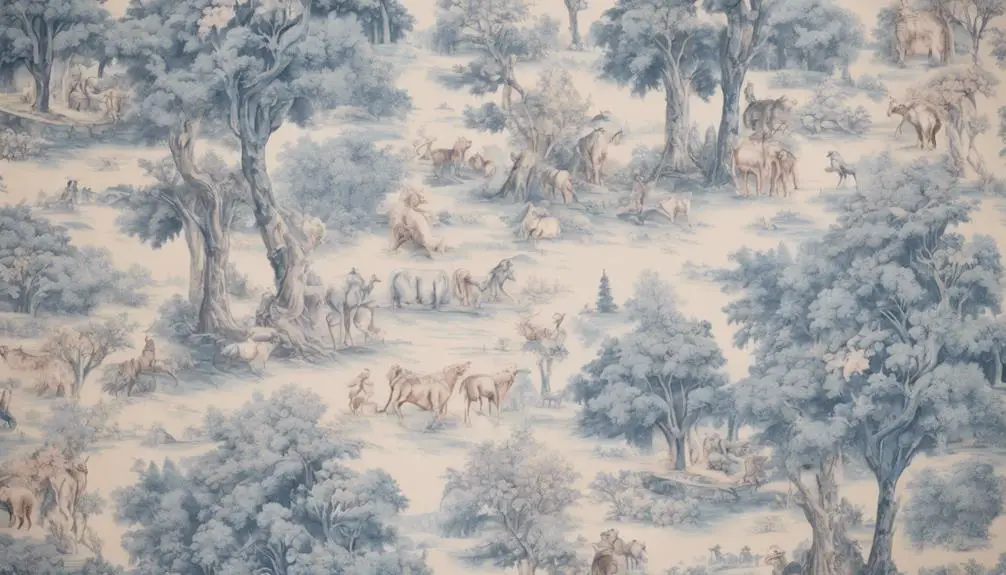
When you explore toile design, you'll find that its intricate patterns tell enchanting stories. The most recognized type, Toile de Jouy, originates from the factory established by Christophe-Philippe Oberkampf in the 18th century. These toile patterns often depict pastoral scenes, floral arrangements, or historical events, all printed on white or off-white printed cotton.
Traditional toile typically features monochromatic colors like blue, red, or black, but modern variations can include vibrant hues and pastels, adding a fresh twist. One of the key advancements in creating these detailed patterns was the introduction of copperplate printing in the 1770s. This technique allowed artisans to produce more intricate designs, enhancing the storytelling capacity of each piece.
As you examine these patterns, you'll notice that they often illustrate themes of love, nature, and rural life, drawing you into a world of charm and elegance. Toile design isn't just about aesthetics; it connects you to historical narratives and the artistry behind textile creation. By understanding these elements, you can better appreciate the beauty and significance of toile in the world of design.
Historical Background of Toile
Toile has a rich historical background that dates back to the mid-1700s in Ireland, where it started as a test fabric for dressmakers. Its journey continued in France, thanks to Christophe-Philippe Oberkampf, who established the Toile de Jouy manufactory in 1760. The term "Toile de Jouy" translates to "cloth from Jouy," referencing Jouy-en-Josas, where Oberkampf produced his exquisite fabrics until 1843.
The popularity of toile surged in Colonial America, becoming a staple in vintage and rustic decor. Below is a brief overview of its evolution:
| Year | Key Development | Significance |
|---|---|---|
| 1760 | Oberkampf opens manufactory | Birth of Toile de Jouy |
| 1770 | Introduction of copperplate printing | Allowed intricate designs |
| 1930s | Revival of toile | Emblematic of vintage style |
| 1970s | Renewed interest | Rustic decor resurgence |
Early toile patterns featured bold colors like black, red, blue, and green, often depicting detailed pastoral scenes on off-white backgrounds. This historical background not only highlights the fabric's origins but also its timeless appeal in various design contexts.
Key Characteristics of Toile
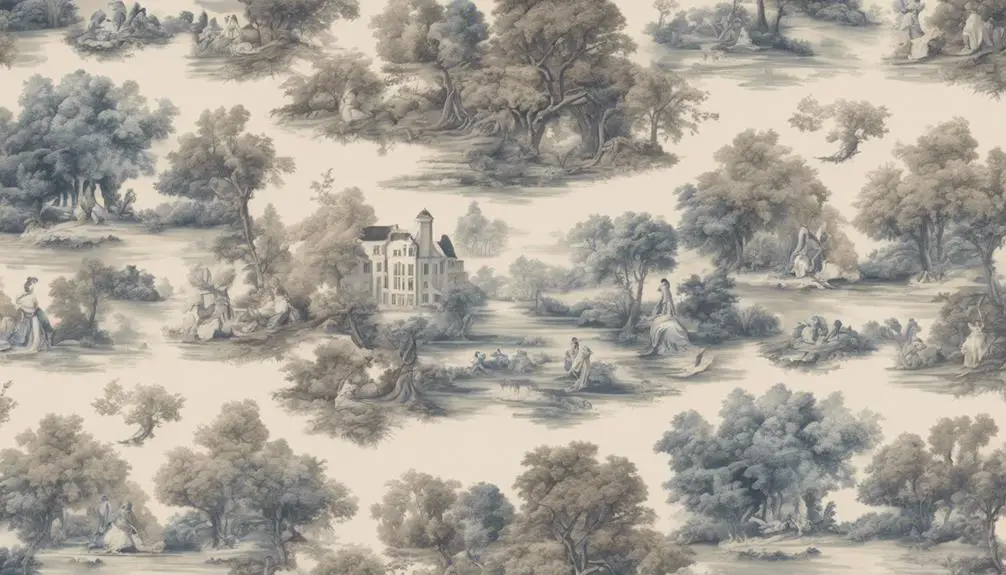
Characterized by intricate designs and vibrant colors, toile captivates with its unique aesthetic appeal. When you look at a toile print, you'll notice it's typically set against a white or off-white background. This stark contrast enhances the detailed motifs, which often depict pastoral or nature-inspired scenes. Traditional toile designs feature bold colors like blue, red, and black, while modern variations may showcase brighter hues and pastels.
One of the key characteristics of toile is its narrative themes. Each print tells a story, illustrating elements of rural life, romantic encounters, or historical events. This rich storytelling adds depth to the design, allowing you to connect with the imagery on a personal level.
Additionally, toile patterns can vary in scale. Larger motifs are often used for upholstery, while smaller designs suit accents like curtains and cushions. You might also find floral and historical designs, each offering its own charm. If you're aiming for a cohesive look, consider using matching toile across different decor elements. This will create a harmonious environment, showcasing the beauty and versatility of toile in your space.
Types of Toile Patterns
Understanding the different types of toile patterns can enhance your appreciation of this unique fabric. These patterns, often associated with the de Jouy style, come in various forms, each offering a distinct aesthetic for your interior design.
Here's a breakdown of the primary types of toile patterns:
| Type of Toile | Description | Common Uses |
|---|---|---|
| Scenic Toile | Depicts landscapes and people, often telling a story | Curtains, upholstery |
| Floral Toile | Features botanical designs, adding elegance | Cushions, bed linens |
| Historical Toile | Illustrates historical events and scenes | Wallpaper, decorative accents |
Traditional toile typically showcases detailed, repetitive patterns on white or off-white fabric, often in simple colors like black or red. In contrast, modern variations incorporate brighter colors and pastels, appealing to contemporary tastes.
You'll also find geometric toile, which combines shapes with patterns, making it a fun choice for a modern twist. Finally, abstract toile offers less defined images, allowing for creative interpretation. By understanding these types, you can select the perfect toile pattern to enhance your space.
Identifying Authentic Toile
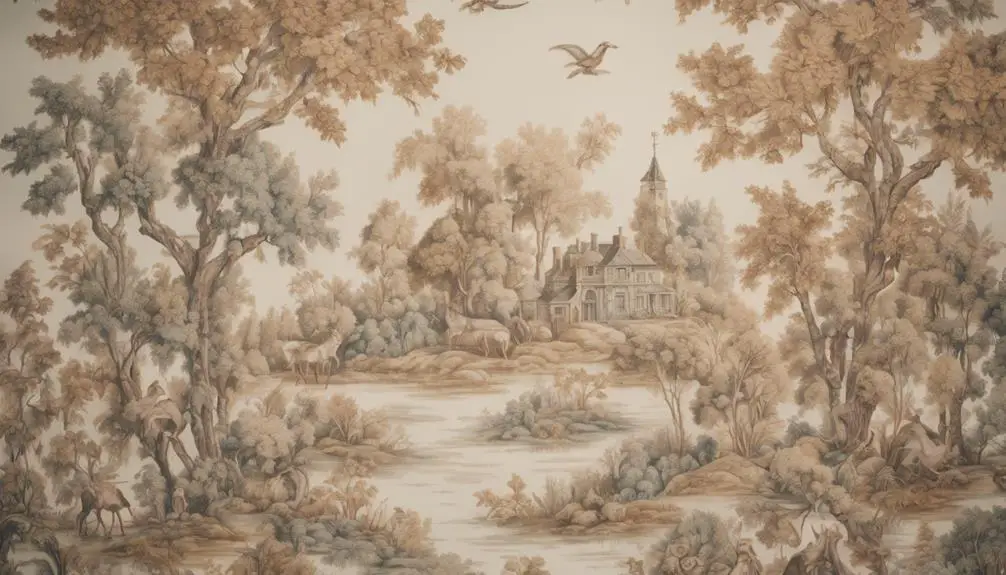
When you're looking to identify authentic toile, pay close attention to the details that set it apart from imitations. Authentic Toile de Jouy typically features a distinctive off-white background adorned with intricately detailed, single-color prints. You'll often find designs that depict pastoral scenes or historical themes, reflecting the storytelling quality that made these textiles famous.
Check the fabric composition; genuine toile is usually made from high-quality cotton or linen. Look for the printing techniques as well—authentic pieces often showcase block printing or copperplate printing, methods popularized in the late 18th century. As you examine the patterns, note the scale: larger designs may indicate a contemporary interpretation, while traditional pieces usually have smaller, repeating motifs.
Don't forget to search for the signature of the designer or manufacturer. Authentic Toile de Jouy often includes markings or stamps, particularly from well-known producers like Christophe-Philippe Oberkampf. By taking these steps, you'll be better equipped to identify authentic toile and appreciate its rich heritage and artistry.
Modern Uses of Toile
Toile has found a dynamic place in modern interior design, transforming spaces with its classic charm and contemporary flair. You'll notice toile prints in various forms, from upholstery to drapery and wallpaper, allowing for both traditional and modern interpretations. Designers like Christian Dior and Vivienne Westwood have embraced this iconic textile in their fashion collections, showcasing its versatility in home decor and high fashion.
Modern interpretations of toile often feature vibrant colors and updated motifs, making it appealing to contemporary tastes while preserving its classic aesthetic. The "total look" concept in modern decor emphasizes the coordination of toile patterns across different textiles, creating a cohesive feel in your space. Whether you're aiming for a French country vibe or a more eclectic aesthetic, incorporating toile can elevate your design.
Toile is celebrated in numerous exhibitions, such as Sheila Bridges' Harlem Toile, which highlights cultural narratives through this historic textile design. As you explore the textiles in the world, remember that toile can add a touch of elegance, storytelling, and artistry to your home decor, blending the old with the new in stunning ways.
Frequently Asked Questions
What Are the Characteristics of Toile?
Toile patterns showcase detailed, repeated designs, often depicting pastoral scenes. You'll notice bold colors like blue or red, along with various motifs such as landscapes and florals, adding charm to your decor.
What Makes a Pattern Toile?
To determine if a pattern's toile, look for detailed, repetitive designs featuring pastoral or historical scenes. The color's usually one tone on a light background, capturing intricate narratives that evoke romance or rural life.
What Is the Toile Mark?
The toile mark's a key indicator of authenticity. It usually displays the manufacturer's name or logo, ensuring you're getting genuine fabric. Look for this label to confirm quality and origin when shopping for toile.
What Is the Difference Between Toile and Toile De Jouy?
Toile refers to any printed fabric, while Toile de Jouy specifically highlights intricate, monochrome illustrations from Jouy-en-Josas. You'll notice the storytelling aspect in Toile de Jouy, unlike the broader themes found in other toile fabrics.
